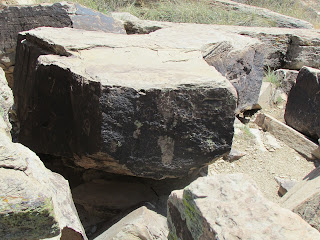There are several solstice markers in the park. This is the easiest to see. You can see the crack in the rock. Near the bottom on the right is a smaller rock that has petroglyph on it. The petroglyph that is a spiral on the darkest part of the rock indicates when the summer solstice is. When the sun shines through the crack in the large rock and shines on the spiral, about June 20, it is the summer solstice or the beginning of the summer season. Ancient peoples all over the world marked the time of the solstices. I always wonder how many years did they have to watch a place to see that the sun would shine at a certain point at that exact day. And why would they watch this certain rock? There is so much land that could mark a solstice or other important event, in such a similar way, that may have never been found even yet.

The spiral is on this rock on the left side. You can see the footprint petroglyph in the front.
See the depression in the large bolder with the water in it? It had rained the day before and there was still water there. I remember reading in old Louis L'Amour books about these "tenna's" I think he called them. (Much as it pains me I cannot find one of his books, quickly, where he writes of this). Larger ones are usually called tanks and can hold a gallon to thousands of gallons. He would have a hero dying from thirst and finding one of these small bowls to keep him going until he could find a creek, or river. I have seen lots of them and I guess it could keep you alive but they usually have insects in them. These rock holes are formed when there is a soft spot in the rock and wind, rain, heat and cold work on the area for many, many years.











Louis wrote a novel about the well at Indian Wells. I forget the name of it. We'll have to look this up and get back to each other. Anyway, our local Indian WOMEN did all the labor on that well. They carved it out inch by inch.
ReplyDelete